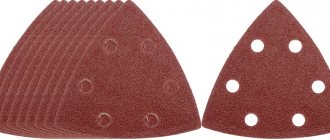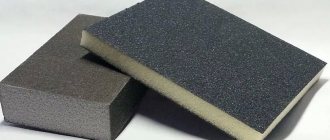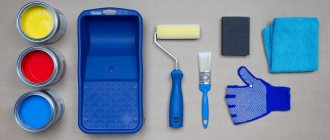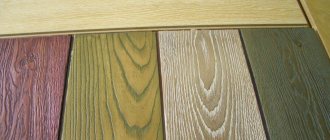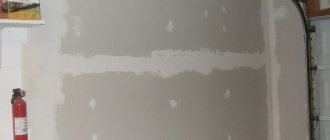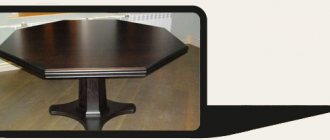When the plastic surface has lost its former decorative qualities, but is still intact and there is a desire to continue to use it, then painting can be applied. Painting will give an aesthetically pleasing appearance, but if done correctly. It is more convenient to choose aerosol paints for this purpose. Details about what kind of paint in cans is suitable for plastic and the rules for its use will be discussed below.
The nuances of coloring plastic
- Plastic is famous for its insulating qualities, and, as a result, mediocre adhesion. In this regard, not every paint will be able to adhere firmly to the polymer surface;
- Hard types of plastic are easier to paint. Paint may peel off soft surfaces that constantly bend during use. For painting soft products, it is best to use elastic enamel;
- If we are talking about a hard type of plastic, such as that from which containers are made, then universal acrylic enamel is ideal for painting;
- Painting is not carried out in the case of such types of plastic as polyethylene, polystyrene and polypropylene.
Painting
Painting plastic
Immediately before painting, the part is degreased, but you should be careful when degreasing near the masking tape; if you do it carelessly, the degreaser may “eat” the glue from the tape and you will have to re-glue it. Important! Never use acetone to degrease plastic! It is aggressive towards plastic and can “eat” it.
After degreasing, almost the most important stage begins - priming. If you apply it incorrectly, you can ruin the part and have to start all over again. A primer for plastic is needed to better fix the paint. It has been proven that unprimed plastic holds paint much worse.
How to apply primer or paint? You can see an example in the gif below.
You need to clearly understand several nuances:
- Shaking the can well is a must! Otherwise, the paint may be sprayed unevenly or even in clumps.
- Spray the first time into the air. Since during the first spray there may be larger particles or air may come out intermittently.
- Never start spraying directly over the part! Otherwise, drips cannot be avoided. You may notice that I start spraying far beyond the contour of the part, yes - this is a greater waste of paint, but in this way the surface is painted evenly and without smudges.
- When applying layers, it is better to alternate the direction of application of the material: apply alternately lengthwise and crosswise.
How much primer should I apply? Two layers, and if the surface is not smooth or has a complex shape, three layers can be applied. After applying each layer, allow intermediate drying for 10-15 minutes.
After the primer is certified, it is worth checking the surface; if it is perfectly covered with the material, you can proceed to the next stage; if there are any unevenness or drips, they should be carefully sanded. It is most convenient to sand away drips.
How to apply paint? Exactly the same as a primer, but you need to be extremely careful: painting does not tolerate mistakes. The paint is applied in at least three layers to ensure reliability and smoothness of the surface.
After painting, move the part to a dry place until it dries completely, usually for a day.
Metal painting
Painting metal includes all the same steps, first the part is degreased, and then, if you have completely stripped the part down to the metal, you will need to apply a metal primer, and if you are confident in the quality of the coating, the paint is applied over the factory coating.
Preparing plastic for painting
If your type of plastic is suitable for coloring, and you really want to change the color on your drinking water bucket, then you need to start with degreasing (solvent, white spirit), treating with an antistatic agent and putty. The latter is necessary if the plastic has flaws and damage. Sanding with sandpaper while exposing it to water will also help remove cracks and cracks if they are small.
The most important preparation step is priming the plastic surface. We have already said that the adhesion of such a polymer coating is extremely mediocre, and a primer will help improve it.
Types and characteristics
You can choose a good spray paint for plastic if you understand the types that are sold in hardware stores. Then you can easily choose the best option for certain working conditions. Below we will discuss enamels by type in more detail.
You can choose a good spray paint for plastic if you understand the types that are sold in hardware stores.
Polymer
The base uses polymers, which make it possible to use them as a primer solution with coloring properties. They are distinguished by a high degree of adhesion. They can be safely used without priming the plastic.
They are distinguished by a high degree of adhesion.
With acrylates and/or polyurethane additives
This type is distinguished by better resistance to mechanical shocks. Therefore, they create additional protection for the base, and are used for surfaces that may be subject to friction and shock.
This type is distinguished by better resistance to mechanical shocks.
Structural
Structural coatings have a rough texture after drying. This helps cover minor surface imperfections. With it you can get a unique and interesting design of the item.
Structural coatings have a rough texture after drying.
Soft touch
This type creates a coating that is pleasant to the touch. It is similar to a rubberized surface, a velvet material. The appearance of the coating stands out due to its attractiveness.
The appearance of the coating stands out due to its attractiveness.
Monadic
They are chosen for PVC type plastic. It is a waterproof paint for plastic in cans. The level of adhesion is high, giving the base protection from ultraviolet rays.
The level of adhesion is high, giving the base protection from ultraviolet rays.
Waterproof
Moisture-resistant types are necessary in cases where there will be constant exposure to water during operation. A barrier layer is created to make the materials last longer.
Moisture-resistant types are necessary in cases where there will be constant exposure to water during operation.
Heat resistant
If the item will be used under high temperature influence, then this property is necessary. Aerosol spraying will be convenient for treating hard-to-reach areas of such items.
If the item will be used under high temperature influence, then this property is necessary.
Matte
Sometimes it is necessary to achieve a matte effect on the surface. There are similar compositions on sale. The matte finish does not highlight stains and can hide minor defects in the base.
The matte finish does not highlight stains and can hide minor defects in the base.
Choosing a primer for plastic
For plastic, liquid acrylic-based enamel primer is used. This component dries quickly, creating a layer on the surface of the plastic that adheres well to the paint. Moreover, such a component is able to retain paint even when exposed to the sun and moisture. Finally, there is a method of applying such a primer by spraying. It is not only fast, but also very economical.
By the way! If, after the primer has dried, you treat it with sandpaper, the surface will acquire a matte color and will adhere to the paint even better.
What to look for when choosing
When deciding what type of dye to purchase, you need to carefully read the main characteristics of the composition indicated on the packaging:
- Adhesion. Most dyes have good adhesion to the surface; they differ only in the degree of adhesive properties. When choosing, you need to take into account the composition and smoothness of the plastic object you plan to paint.
- Base compatible. Enamel for plastic must be suitable in composition to the type of surface being painted or to the primer applied to it. Failure to follow this rule will result in the decorative layer quickly cracking or blistering.
- Spreadability and hiding power. These parameters show how evenly and thickly the paint is applied to the material.
- Water resistance. All acrylic paints and varnishes used for plastic surfaces are waterproof; after drying, the resulting film can be washed. But for products located in conditions of high humidity, additional additives, often polyurethane, are added to increase water resistance.
- Aesthetics. Depending on the result you need to get, you can use plastic paint that gives a flat, smooth surface, or choose structural painting.
- Consistency with the basis. The instructions always indicate what type of plastic can be painted with this product.
Paint for plastic: choice
Spray paint is the best way to give plastic a new color. It fits perfectly, applies smoothly and very quickly. There are special types of paint created specifically for these polymer products. At the same time, the rapid drying is also noteworthy. The disadvantage of this paint is the inability to make clear boundaries without using masking tape, as well as the difficulty of painting small parts and mixing colors on the same surface.
Painting with universal or plastic acrylic enamel. Typically, delicate work is carried out in this way, or parts that do not require special attention are painted. The reason is that it takes longer to dry, during which the sticky surface can become dirty.
By the way! There is information on the Internet about the successful use of leather paint on plastic. It is applied after preliminary degreasing. At the same time, the coating lies smoothly and firmly.
How to paint car interior plastic
- Sand it.
- Degrease.
- Find out whether it needs to be primed or not.
- Restore texture if necessary.
- Paint it the desired color.
How to sand
To matt interior plastic under primer, red Scotch-Brite is usually sufficient. It is a felt-based abrasive material, similar to the hard side of a dish sponge. The advantage over fine-grained sandpaper is its softness, which allows this tool to efficiently process various bends and indentations.
How to degrease
Experienced painters advise using only anti-silicone. The fact is that classic solvents in the form of white spirit or solvent can ruin a plastic unit. For example, after using organic matter, stains form that are difficult to hide even with painting. By the way, we have already recommended abandoning white spirit when performing the technology that describes how to remove tar from a car body without damaging the paint.
Do you need primer on plastic or not?
The reason for fresh paint clumping and peeling is that no primer was applied first. This is a composition with a special formula of various additives and plasticizers, which improves the adhesion of paint to the surface. However, not all plastics require primer treatment. To determine whether to prime the interior plastic or not, you need to conduct two experiments:
- Set fire to a piece of the product being processed.
- Immerse the part in water.
If the plastic smokes and sinks, it is not necessary to use primer on the plastic.
When a plastic element burns like a wax candle and floats on water, you cannot do without a primer. It is important to choose the soil wisely. So ordinary automotive compounds are not suitable - the paint peels off instantly
You need a special primer designed specifically for plastic.
When is structural paint needed?
If you have ever touched a black plastic bumper or a dark side mirror housing on an inexpensive car, you probably felt that the tactile surface seemed to be covered with small pimples. The matte rough effect is structural plastic. The paint in question recreates this same effect and is typically used to cover up scuffs and light scratches.
What about the paint itself?
First decide what kind of coverage you want to get. Here are some examples:
- Soft-Touch. Usually used for dashboards. The surface is slightly silky and rubberized. This coating is applied to the panel from the factory.
- Normal, rough. Apply to hard plastic. For example, the side parts of the center console, lower trims on door cards or handles for closing doors.
- Glossy. Used for finishing interior levers intended for opening the door.
Then find out for yourself which shade to choose. If you plan to paint the interior exclusively in a restoration manner, then take the trouble to find a company catalog with the distribution of interior and exterior colors by VIN numbers. The original paint, selected according to the factory catalog (for example, for VW it is ETKA), will preserve the monotony of the overall picture of the interior. This will be because there will be no noticeable difference between the painted and unpainted parts.
If we talk in terms of the examples given, then it is better to purchase the Soft-Touch aerosol can through the official line. To get a regular rough layer, it is enough to use classic paint paired with structural paint. Here are examples for common shades:
- Black. The VAZ black Cosmos (code 665) will do.
- Grey. The VAZ decorative (graphite) intended for bumpers fits perfectly.
However, the color and origin of the paint are purely individual things and are selected solely according to one’s own preferences. Continuing the conversation about rough coatings, it is appropriate to mention the well-known RAPTOR U-POL, a protective coating for the exterior of a car, and its similarity - HB BODY.
Glossy objects are regular paint covered with several layers of varnish. The latter is recommended to be purchased in aerosol cans. There are no strict requirements for this component.
We recommend painting plastic parts of the car interior only with a spray can. When applying enamel with a brush, there is a risk of drips. In addition, such a layer takes much longer to dry, which means that the likelihood of catching dust particles is much higher.
Plastic coloring process
- Before painting, it is better to cover with masking tape all those places that will not be treated. This is especially important when working with paint in cans;
- Regardless of what exactly you paint the plastic with, it is best to apply 2-3 layers;
- When working with an aerosol, the latter must be shaken for at least 30 seconds. At the same time, keep the sprayer at a distance of 20-30 centimeters from the surface to be painted. If you want to simplify the application of paint, making it more precise, you can use nozzles on a spray can;
- When painting with a brush, try to apply the coating in a thin layer, pressing the tool to the surface. At the same time, make sure that the angle is approximately the same. It is better to apply a layer of paint in a wide stripe for greater uniformity, and then shade it to get into all the pores. It is better not to submerge the brush completely when applying paint to it.
Tools and materials for painting plastic
Before painting plastic parts, prepare the necessary items that will be needed during work. Many paints dry quickly, and you should not be distracted from the process. You will need:
- Dyeing agent, you need to purchase the required volume so that the parts do not differ in shade;
- Varnish, applied as a finishing layer to improve the result;
- The master must wear protective gloves, a respirator (if working indoors), and goggles;
- Film, newspaper, to cover elements that should not be painted;
- Scotch;
- A container of water, cloths, detergent;
- Thinner, for example, white-spirit;
- Fine-grained sandpaper;
- If there are unevenness, putty mixture and primer.
Before painting plastic parts, prepare the necessary items that will be needed during work.
